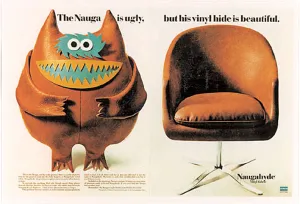How the Nauga and its Fictional Friends Helped Make Synthetic Fabric Cuddly
What started out as an advertising ploy turned into a low-key cultural phenomenon
/https://tf-cmsv2-smithsonianmag-media.s3.amazonaws.com/filer/85/96/85964eb7-faf4-43b2-93df-8a050c1e8598/8048739912_590e2fcf16_o.jpg)
Save the Nauga!
That was the cry of amateur standup comedian Al Rosenberg in September 1981, pretending to be eccentric inventor Earl C. Watkins (not a real person), leader of the “Save the Nauga” campaign. Watkins regularly appeared on a local radio show, wrote Fred Ferretti for The New York Times that month. But unlike Watkins’s other charitable campaigns, such as the Fund to Aid the Venetian Blind and Save the India Napless 500, a campaign “to help a small village near New Delhi that is afflicted with insomnia,” the Nauga campaign had a proud history.
According to the makers and advertisers of naugahyde, the Nauga–the creature from whose leather-like skin couches and other furniture are made–is a gentle but tough beast. “Invite a Nauga to your next party,” one November 1967 advertisement encourages readers. “Punch him in the nose the minute he comes through the door. Spill a Bloody Mary on him. Get him with a pie in the face. Smear chocolate on his chest. Kick him around. His vinyl hide is Naugahyde vinyl fabric. It’s indestructible.”

In case you haven’t figured it out, the Nauga is a fictional creature. Naugahyde is a synthetic leather replacement, trademarked in 1936, while the Nauga was born of a late 1960s advertising campaign, according to Barbara Mikkelson writing for Snopes. The cutesy Nauga advertisements and cuddly Nauga dolls (now very collectible) were intended to soothe “customers’ unfamiliarity with what might otherwise have been perceived as a distinctly synthetic (and thus at the time a slightly threatening) product,” Mikkelson writes. Even Garfield creator Jim Davis got in on the joke in June 1981, when the coffee-loving cat demanded of his owner Jon “Do you know how many Naugas they killed to make this leash?”
While the Nauga is the first and best-known of the cryptozoological creatures who furnish synthetic textiles to the masses, it’s far from the only one. Here are a few of the others mentioned by concerned citizens during a 1992 letter-writing campaign to the Wisconsin State Journal in Madison, mentioned by Mikkelson. A local scientist wrote in to the paper's editorial section, lamenting the plight of a little-known but important animal. His quirky wit inspired others, and a whole host of synthetic creatures were singled out for attention. History does not record if action was every taken to remedy their plights.
The Belgian Velcro
In a letter headed “The sad tale of Velcro’s source,” University of Wisconsin microbiologist Dean O. Cliver lamented the plight of the velcro. Cliver was a world-renowned researcher who died in 2011.
“No matter what you might have read, Velcro was not invented,” he wrote (it absolutely was). “It was developed as a use for the skins of darling little creatures that live in central Belgium. They are lured into large plastic bags by the aroma of gender-specific sex attractants (the males actually fight each other to get in) and then are heartlessly suffocated.”
The Ester Squirrel
“Many people in the United States do not realize that polyester fabrics sold here are not all formed from the chemical reactions called polyesterification,” wrote Eric Rothstein in a response to Cliver’s letter. “While 98 percent of polyester does come from polyesterification, the two percent extra is a product from the ester squirrel.” More than a million esters die every month in the production of polyester, he wrote.
The Nuff
The letter-writers didn’t forget the Nauga. “Thank goodness we have come to our senses and are beginning to examine the plight of these exploited creatures!” Madison local Joyce Carey wrote on February 15. Nor did they forget the Nuff–at least not letter-writer Elaine Kearney. “People unknowingly step on these and run over them in their cars,” she wrote, “but they are actually warm, cuddly and friendly. After all, a nuff is a nuff.”